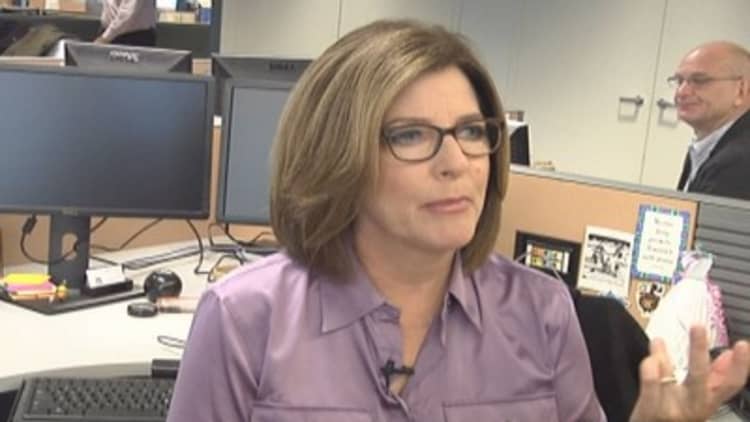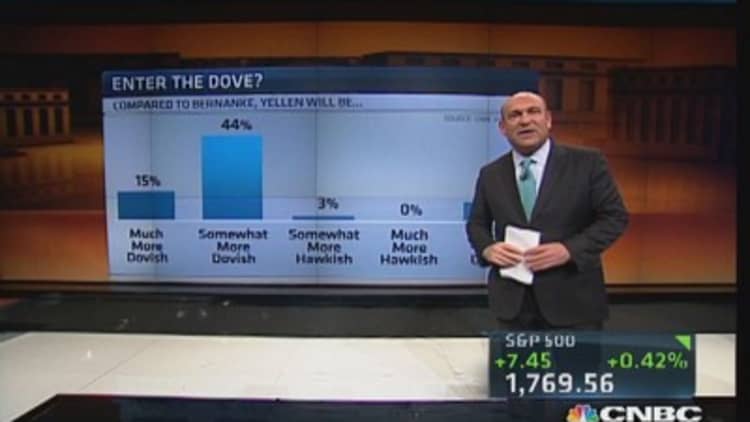
Markets are primed for a dovish statement from the Federal Reserve on Wednesday that should keep a lift in stocks.
The Dow and rallied to record highs Wednesday morning after closing at new highs Tuesday, as traders bet on an uneventful outcome when the Fed ends its two-day meeting Wednesday afternoon.
"They (traders) put the possibility of a surprise tapering at zero," said Art Cashin, director of floor operations at UBS. He said there was some short-covering Tuesday as traders assumed the Fed would not announce any reduction in its $85 billion monthly bond-buying program.
The Fed issues its statement at 2 p.m. EDT, and there is no press briefing with Chairman Ben Bernanke this month. Fed watchers do say the Fed could tweak its view on the economy, to show the uncertainty that has resulted after the government shutdown.
Traders were more focused than usual on the 8:15 a.m. ADP private sector employment report, which showed a weak 130,000 gain in private sector employment in October. The September number was revised down to 145,000 from 166,000. The number reinforced their view that the Fed would take no action in the near future.
The government's monthly employment report usually follows ADP within two days, but because of the government shutdown, the October jobs report will be delayed until Nov. 8.
(Read more: ADP releases scary October jobs report)
Employment is a key metric for the Fed, and the government's September jobs report was disappointing when it was released after a several week delay. Only 148,000 nonfarm payrolls were created in September, and economists expect the government's October report to be weak due to the 16-day government shut down.
The Fed surprised markets after its September meeting, when it announced no change in its bond purchases, so every new employment report is important. The Fed instead cited financial conditions and concerns about fiscal headwinds as reasons not to cut back.
Barry Knapp, head of equity portfolio strategy at Barclays, said after that meeting he raised his year-end target for the S&P 500 to 1,800.

Knapp said historically the market has corrected when the Fed pulls back from easing, with an average 8 percent decline. "We basically pushed that correction into next year," he said.
The CNBC Fed Survey this week found that Wall Street now expects the Fed to maintain its current level of purchases of Treasury and mortgage securities until April.
"They're on hold until they can get a cleaner read from the data that's not distorted by government shutdown and they reassess where the economy stands," CRT Capital senior Treasury strategist Ian Lyngen said. "There is tail risk that the Fed does something more hawkish that the market is not prepared for. I would ascribe a very small probability but that's the one thing that could shock the market."
The Dow on Tuesday soared 111 points to 15,680, besting its Sept. 18 closing high and catching up with other indexes that had already set new highs. The S&P 500 was up 9 at 1,771. The Dow temporarily broke above its September intra-day high of 15,709 in early trading Wednesday.
(Read more: QE expected to continue through 2014: CNBC survey)
"We have this favorable set up where public and monetary policy are both generally improving. I think the economic outlook is generally improving as well," Knapp said.
He also said the market is now in a seasonally positive time. "There were only four fourth quarters since 1990 when the returns were negative," he said. The last time the market registered a loss in a fourth quarter was when the recession was in full swing in 2008.
"I don't see much to stop it now," Knapp said. He said he expects the upcoming budget negotiations in Washington to be less contentious and he does not expect the Fed to announce that it will taper its bond buying until March.
Jack Ablin, CIO of BMO Private Bank, said Fed officials may say something more hawkish to keep the markets thinking about tapering, even if they don't do it yet.
"My guess is they're going to take a more hawkish tone. I think they're going to have to get the idea of tapering in the future back in the system. I don't think they do it. I just think they have to talk about it again," he said.
But that should not stop stocks from moving higher. The S&P 500 "is about 10 percentage points above the 200-day moving average. This is a very good story. The most likely scenario is the market tends to gain 10 to 15 percent in the subsequent 12 months," said Ablin.
The Fed likes the animal spirits it is creating, he said. "What they want to do is have their monetary policy stimulate activity but they don't want to create a bubble in the meantime," he said.
—By CNBC's Patti Domm. Follow here on Twitter @pattidomm.


